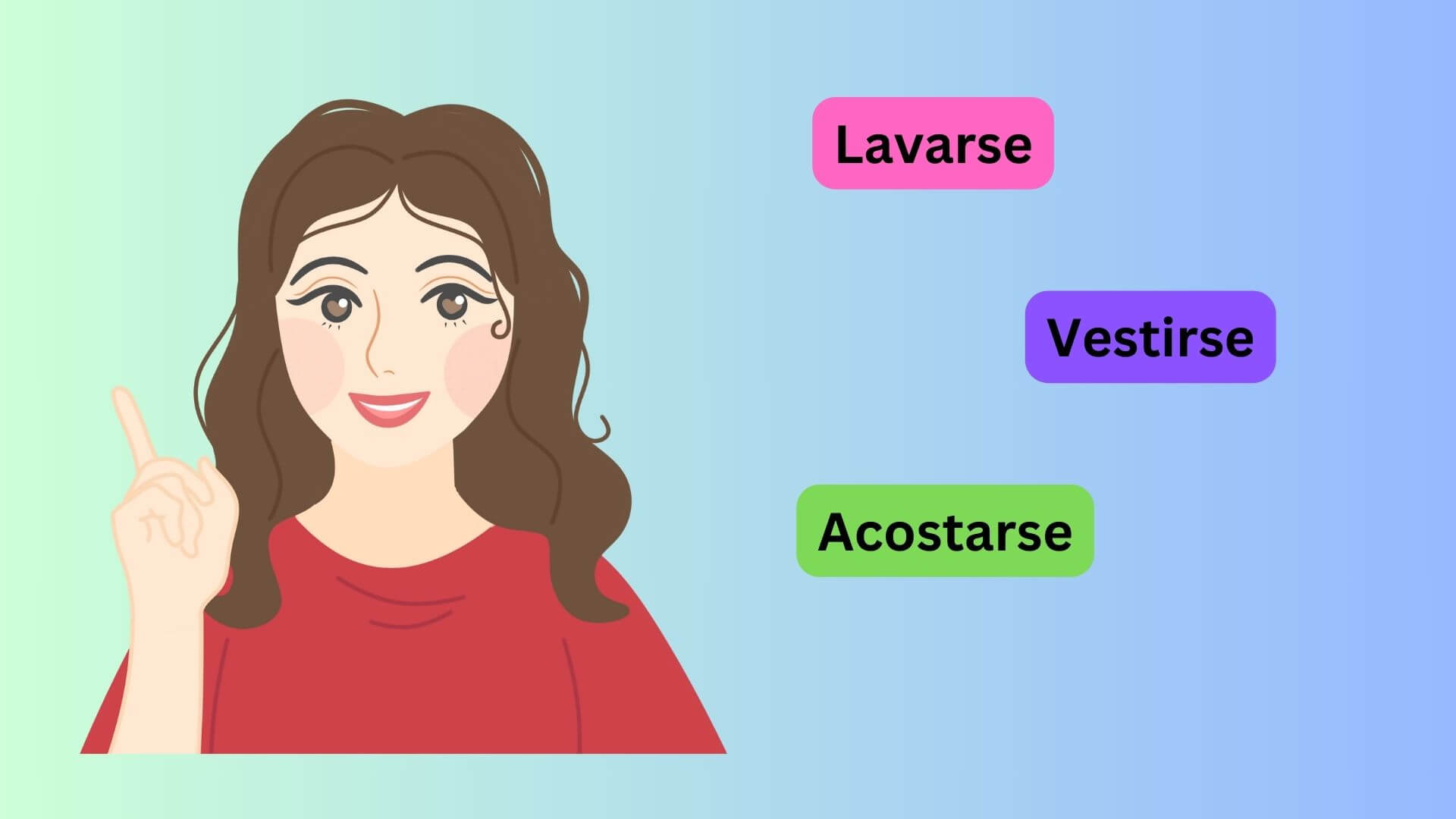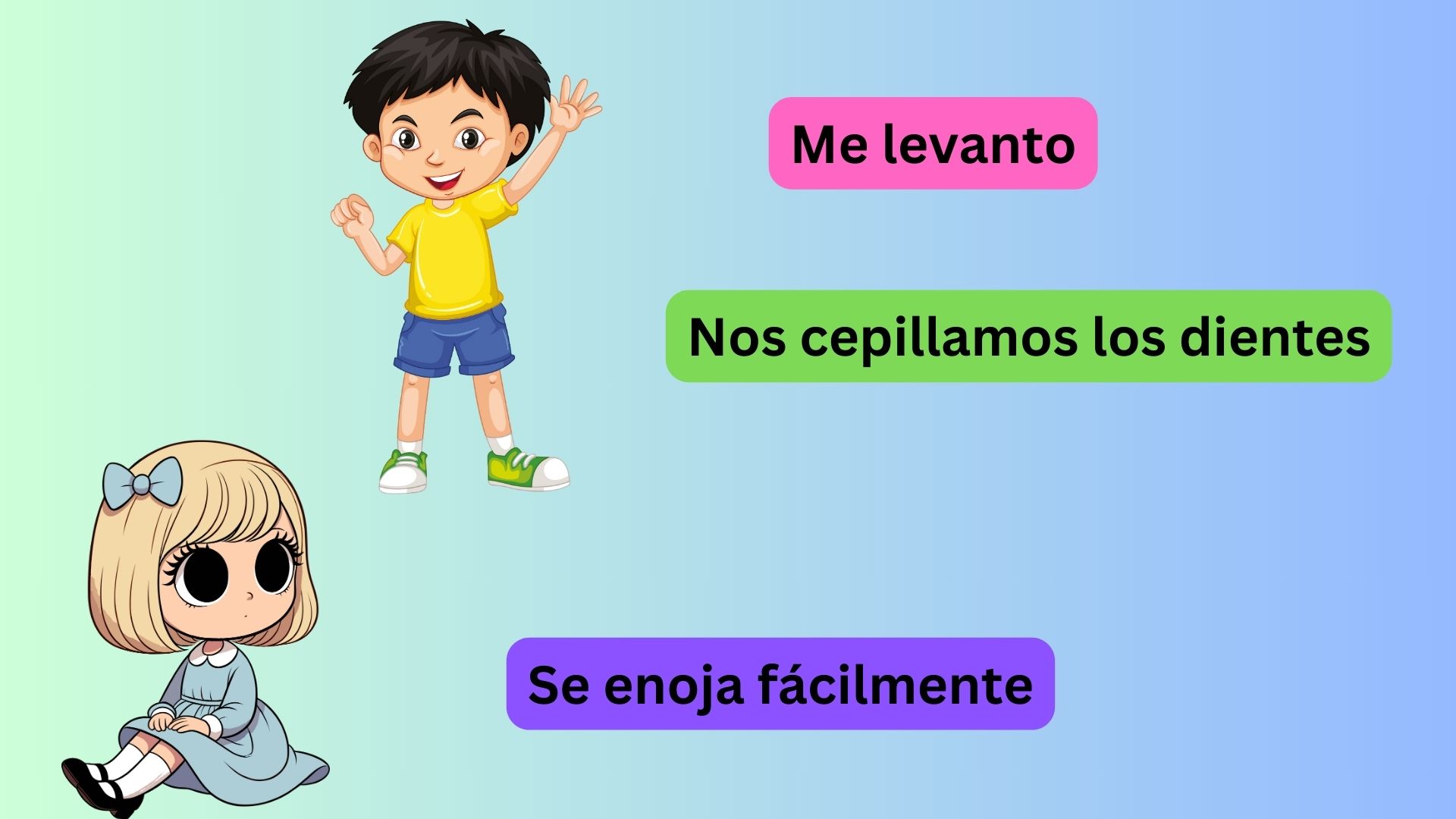Learning reflexive verbs in Spanish is crucial. They don’t just help you get the grammar right; they also make your conversations sound more natural. These verbs are a big part of everyday Spanish.
This guide will simplify reflexive verbs and show you how to use them properly when you speak or write. As we explore how reflexive verbs work, you might start to see how they shape how people talk about their experiences and relate to each other.
Understanding Reflexive Verbs in Spanish

Definition of reflexive verbs
In Spanish, reflexive verbs show that the person doing the action is also the one it affects. These verbs are key to talking about daily tasks and self-care clearly. They help clarify both who is acting and who is benefiting.
- Lavarse: Think of someone washing their face in the morning. They do the washing, and they get washed.
- Vestirse: Imagine a child putting on their clothes alone. The action comes back to the one doing it.
- Acostarse: Picture someone going to bed. The action starts and ends with the same person.
These verbs help us talk about what we do for ourselves, from waking up to going to sleep.
When to use reflexive verbs
Understanding when to use reflexive verbs in Spanish is about knowing when the subject is doing something to themselves. These verbs are needed when the person doing the action is also receiving it. Reflexive verbs add a special touch, making it clear you’re talking about doing something to yourself rather than to someone else. This helps make your meaning clear and adds depth to what you’re saying.
65 Common Reflexive Verbs And Their Meanings
| Spanish Verb | Meaning |
| Acostarse | to go to bed |
| Afeitarse | to shave |
| Bañarse | to bathe |
| Cepillarse | to brush (hair, teeth) |
| Despertarse | to wake up |
| Dormirse | to fall asleep |
| Ducharse | to take a shower |
| Enfermarse | to get sick |
| Enojarse | to get angry |
| Lavarse | to wash oneself |
| Levantarse | to get up |
| Maquillarse | to put on makeup |
| Peinarse | to comb one’s hair |
| Ponerse | to put on (clothes) |
| Quitarse | to take off (clothes) |
| Sentarse | to sit down |
| Sentirse | to feel (emotionally, physically) |
| Vestirse | to get dressed |
| Aburrirse | to get bored |
| Alegrarse | to be glad |
| Asustarse | to get scared |
| Atreverse | to dare |
| Calmarse | to calm down |
| Cansarse | to get tired |
| Casarse | to get married |
| Divertirse | to have fun |
| Emocionarse | to get excited |
| Enamorarse | to fall in love |
| Enojarse | to get angry |
| Entristecerse | to get sad |
| Equivocarse | to make a mistake |
| Irse | to go away, to leave |
| Mudarse | to move (residences) |
| Olvidarse | to forget |
| Preocuparse | to worry |
| Quejarse | to complain |
| Reírse | to laugh |
| Relajarse | to relax |
| Reunirse | to meet, to gather |
| Sorprenderse | to be surprised |
| Acercarse | to approach |
| Acordarse | to remember |
| Alejarse | to move away |
| Arrepentirse | to regret |
| Callarse | to be quiet |
| Cortarse | to cut oneself |
| Despedirse | to say goodbye |
| Divorciarse | to get divorced |
| Esconderse | to hide |
| Imaginarse | to imagine |
| Lastimarse | to hurt oneself |
| Llevarse | to get along |
| Mudarse | to move (residences) |
| Negarse | to refuse |
| Parecerse | to look like, to resemble |
| Portarse | to behave |
| Prepararse | to get ready |
| Quedarse | to stay |
| Recuperarse | to recover |
| Resbalarse | to slip |
| Secarse | to dry oneself |
| Subirse | to get on, to climb |
| Tropezarse | to stumble |
| Verse | to see oneself, to look (a certain way) |
| Volverse | to become |
Mastering Reflexive Verbs in Spanish
Learning reflexive verbs in Spanish means really getting the hang of changing their forms and using them correctly when speaking or writing. The best way to get good at this? Practice a lot and try using them when you’re talking in everyday situations.
Conjugating reflexive verbs

Conjugating reflexive verbs in Spanish means you add a special pronoun before the verb. Sometimes, though, you might put this pronoun somewhere else. Getting this right is key to understanding the language because it shows someone doing something to themselves.
- Imagine a morning routine: Think about someone saying ‘Me levanto’ which means ‘I get up.’ The ‘me’ tells you that the person is doing the action to themselves.
- Think about how we show feelings: Picture someone saying ‘Se enoja fácilmente’ or ‘He gets angry easily.’ The ‘se’ shows that the anger is something happening inside the person.
- Consider daily self-care: Imagine saying ‘Nos cepillamos los dientes’ which means ‘We brush our teeth.’ The ‘nos’ lets you know that the action involves the whole group.
Tips for using reflexive verbs correctly
To use reflexive verbs in Spanish well, you need to know when and how to use them. Here’s how to get it right:
- Spot the Reflexive Action: Check if the action is being done to the person doing it. Like “lavarse” means to wash oneself.
- Where to Put the Pronoun: Usually, put the reflexive pronoun before a regular verb or attach it to the end of an infinitive or gerund. For example, you can say “me estoy peinando” or “voy a peinarme”.
- Practice Makes Perfect: Get comfortable with common reflexive verbs such as “vestirse,” “sentirse,” or “acostarse.” It helps you get better.
- Know the Context: Figure out when a verb has to be reflexive based on what the sentence is about. This makes both understanding and speaking clearer and easier.
Keep these tips in mind and practice a lot. Correctly using reflexive verbs in Spanish will become second nature.
Conclusion
To wrap things up, getting the hang of reflexive verbs really matters if you want to communicate well in Spanish. These verbs help you talk clearly and deeply about daily stuff, taking care of yourself, and how you feel.
As you keep learning and using these rules, you’ll get better and better at Spanish. Think of this guide as your starting point to really get Spanish under your belt.

